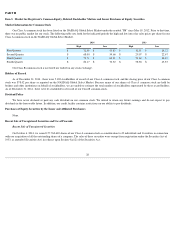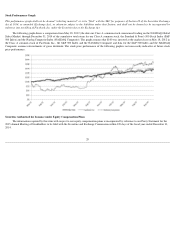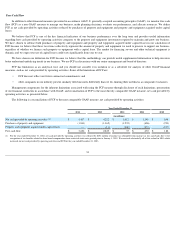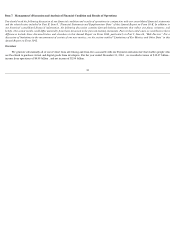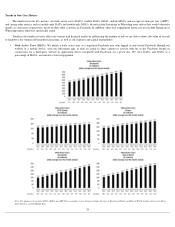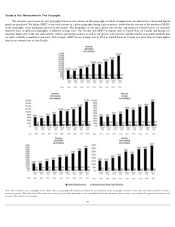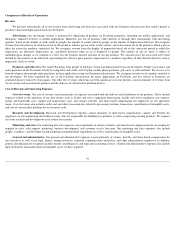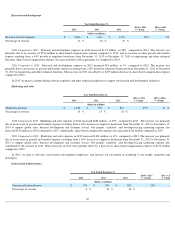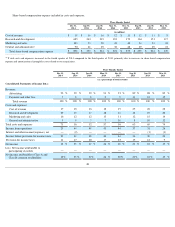Facebook 2014 Annual Report Download - page 41
Download and view the complete annual report
Please find page 41 of the 2014 Facebook annual report below. You can navigate through the pages in the report by either clicking on the pages listed below, or by using the keyword search tool below to find specific information within the annual report.
For 2014 , worldwide ARPU was $9.45 , an increase of 39% from 2013
. Over this period, ARPU increased by approximately 53% in United
States & Canada, 44% in Europe, 42% in Asia-
Pacific, and 27% in Rest of World. User growth was more rapid in geographies with relatively lower
ARPU, such as Asia-
Pacific and Rest of World. We expect that user growth in the future will be primarily concentrated in those regions where ARPU is
relatively lower, such as Asia-
Pacific and Rest of World, such that worldwide ARPU may continue to increase at a slower rate relative to ARPU in any
geographic region, or potentially decrease even if ARPU increases in each geographic region.
Critical Accounting Policies and Estimates
Our consolidated financial statements are prepared in accordance with U.S. generally accepted accounting principles (GAAP). The preparation of
these consolidated financial statements requires us to make estimates and assumptions that affect the reported amounts of assets, liabilities, revenue,
costs and expenses, and related disclosures. We evaluate our estimates and assumptions on an ongoing basis. Our estimates are based on historical
experience and various other assumptions that we believe to be reasonable under the circumstances. Our actual results could differ from these estimates.
An accounting policy is deemed to be critical if it requires an accounting estimate to be made based on assumptions about matters that are highly
uncertain at the time the estimate is made, if different estimates reasonably could have been used, or if changes in the estimate that are reasonably
possible could materially impact the financial statements. We believe that the assumptions and estimates associated with revenue recognition for
payments and other fees, income taxes, share-
based compensation, loss contingencies, and business combinations and valuation of goodwill and other
acquired intangible assets have the greatest potential impact on our consolidated financial statements. Therefore, we consider these to be our critical
accounting policies and estimates. For further information on all of our significant accounting policies, see Note 1 of our accompanying Notes to
Consolidated Financial Statements included in Part II, Item 8, "Financial Statements and Supplementary Data" of this Annual Report on Form 10-K.
Revenue Recognition for Payments and Other Fees
We enable Payments from people to purchase virtual and digital goods from developers. People can make payments on Facebook by using debit
and credit cards, PayPal, mobile phone payments, gift cards, or other methods. We receive a fee from developers when a person engages in a payment
transaction for the purchase of a virtual or digital good on the Facebook website. The price of the virtual or digital good is a price that is solely
determined by the developer. We remit to the developer an amount that is based on the total amount of transaction less the processing fee that we charge
the developer for the service performed. Our revenue is the net amount of the transaction representing our processing fee for the transaction. We record
revenue on a net basis as we do not consider ourselves to be the principal in the sale of the virtual or digital good to the person. Under GAAP guidance
related to reporting revenue gross as a principal versus net as an agent, the indicators used to determine whether an entity is a principal or an agent to a
transaction are subject to judgment. We consider ourselves the agent to these transactions when we apply the indicators to our facts. Should material
subsequent changes in the substance or nature of the transactions with developers result in us being considered the principal in such sales, we would
reflect the virtual and digital goods sale as revenue and the amounts paid to the developers as an associated cost.
Income Taxes
We are subject to income taxes in the United States and numerous foreign jurisdictions. Significant judgment is required in determining our
provision for income taxes and income tax assets and liabilities, including evaluating uncertainties in the application of accounting principles and
complex tax laws.
We record a provision for income taxes for the anticipated tax consequences of the reported results of operations using the asset and liability
method. Under this method, we recognize deferred tax assets and liabilities for the expected future tax consequences of temporary differences between
the financial reporting and tax bases of assets and liabilities, as well as for operating loss and tax credit carryforwards. Deferred tax assets and liabilities
are measured using the tax rates that are expected to apply to taxable income for the years in which those tax assets and liabilities are expected to be
realized or settled. We record a valuation allowance to reduce our deferred tax assets to the net amount that we believe is more likely than not to be
realized.
We recognize tax benefits from uncertain tax positions only if we believe that it is more likely than not that the tax position will be sustained on
examination by the taxing authorities based on the technical merits of the position. Although we believe that we have adequately reserved for our
uncertain tax positions, we can provide no assurance that the final tax outcome of these matters will not be materially different. We make adjustments to
these reserves when facts and circumstances change, such as the closing of a tax audit or the refinement of an estimate. To the extent that the final tax
outcome of these matters is different than the amounts recorded, such differences will affect the provision for income taxes in the period in which such
determination is made and could have a material impact on our financial condition and operating results. The provision for income taxes includes the
effects of any reserves that we believe are appropriate, as well as the related net interest and penalties.
38


